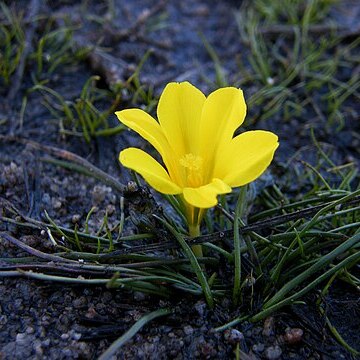Perennial herb, geophyte, 0.03-0.06 m high; solitary or forming thick clumps; corm with brown, fibrous tunics. Leaves 30-80 mm long, linear, grass-like, bifacial, canaliculate ± erect, spreading or falcate, unifacial distally, margins with hyaline borders, smooth or minutely ciliate. Inflorescence with pale yellow flowers in basal tufts; perianth tube 10-24 mm long; tepals 15-19 x 4-9 mm, subequal, ovate, obtuse. Stamens: filaments usually entirely united, 3-6 mm long; anthers 1.5-4.0 mm long, diverging. Ovary with style usually exceeding anthers; stigma fringed. Flowering time July-Sept.
Corm c. 1 cm diam. Leaves linear to narrowly lanceolate, channelled, terete near apex, up to 7 cm long, 1–2.5 mm wide; margins hyaline. Flower yellow, scented. Perianth tube 10–24 mm long; lobes similar, oblanceolate, apiculate, 14–18 mm long, 4–8 mm wide. Sepals sometimes purple-marked. Filaments 4–5 mm long, usually completely connate; anthers 1.5–3 mm long. Style branches short, cuneate, level with or exceeding anthers; stigmas fringed. Capsule 7–9 mm long. Stem of fruiting plant elongating up to 12 cm long, erect, terete, c. 1 mm diam.
Stemless, cormous geophyte, 30-60 mm tall. Leaves linear to terete, more-or-less erect. Flowers in a basal tuft, yellow, tubular below, tepals cupped, filaments united in a column, style exceeding anthers, style lobes fringed.
Acaulescent, cormous geophyte, 3-6 cm. Leaves linear to terete. Flowers yellow, tepals cupped, style exceeding anthers, stigmas fringed.

